Introduction:
The decision to pursue a divorce is never an easy one, but understanding the divorce process new york is a crucial step toward reclaiming control of one's life. In the vibrant state of New York, where the tapestry of life is as diverse as its residents, the divorce process is a multifaceted journey that requires knowledge, support, and careful navigation.
Grounds for Divorce:
In the state of New York, couples can file for divorce under both fault-based and no-fault grounds. While traditional fault-based grounds may include issues like cruelty or abandonment, the introduction of no-fault divorce in 2010 allows couples to seek divorce without proving wrongdoing. Understanding the grounds and their implications is the first step in initiating the divorce process.
Initiating the Process:
The divorce process begins with the filing of a Summons with Notice or a Summons and Complaint, outlining the grounds for divorce and the relief sought. This legal document is then served to the other spouse, initiating the legal proceedings. It's essential to consult with a knowledgeable family law attorney at this stage to ensure accurate and comprehensive filing.
Temporary Orders and Preliminary Conferences:
During the divorce process, either party may seek temporary orders for issues like child custody, support, or exclusive use of property. Preliminary conferences are then scheduled to address these matters and establish a timeline for the divorce proceedings. These conferences provide an opportunity for negotiation and may set the tone for the overall process.
Discovery and Negotiation:
Discovery involves the exchange of information and documents relevant to the divorce case. This phase is crucial for building a comprehensive understanding of each party's financial situation, assets, and liabilities. Following discovery, negotiations begin, whether through direct communication, mediation, or collaborative law, with the goal of reaching mutually agreeable settlements on issues such as property division, alimony, and child custody.
Trial and Resolution:
If negotiations do not lead to an agreement on all issues, the divorce case may proceed to trial. Here, each party presents evidence and arguments, and a judge makes decisions on unresolved matters. While trials are less common as most cases settle before reaching this stage, they are a part of the divorce process that demands thorough preparation and legal representation.
Finalizing the Divorce:
Upon reaching a settlement or receiving a judgment from the court after a trial, the divorce is ready for finalization. This involves the preparation and submission of final documents, including the Judgment of Divorce, to the court. Once approved, the divorce is finalized, and each party is legally free to move forward with their lives.
Conclusion:
The divorce process new york is a complex and emotionally charged journey, demanding careful navigation and expert guidance. Whether it's understanding the grounds for divorce, initiating the legal process, or reaching a settlement, knowledge is key. Seeking the counsel of a skilled family law attorney provides the support needed to navigate the rapids of divorce, empowering individuals to embrace new beginnings and embark on a path toward a brighter future.









